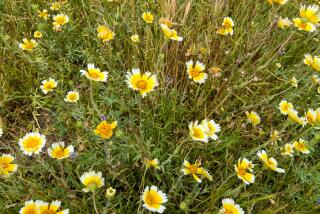Hitting the Trail in Search of Natural and Family History
- Share via
We meandered through the spring-green hills and valleys of the high country, past Warner Hot Springs, and eventually made our descent to the flatness of the Anza Borrego desert.
Even in this starkly majestic and sun-parched land, there was evidence of Edna St. Vincent Millay’s “idiot” springtime that arrives “babbling and strewing flowers,” albeit a restrained babbling and strewing.
The lupine--and a very good year it is for lupine, particularly in the high country above Borrego--were strewn profusely all along our route, but less so on the desert floor. Yucca blossoms were in that early stage where the petals were closed in pregnant rotundity. Ocotilla were just beginning to tip its??? unreal stems with orange-red. I know not the names of the little yellow flowers we passed on our journey, perhaps yellow cups, saucers and eyes, but they were making brave stands from high to low country.
Even the road on which we traveled had its origin in a spring-sounding name: Butterfield Trail. But more of that in a moment. The purpose of my wife’s and my drive to Borrego was to attend a family gathering to celebrate the 75th birthday of my late, first wife’s brother, Clarence L. Sorensen, otherwise known as Clancy, “the big Scandahoovian.” I shan’t list all of the family there, expect to note that a sizable contingent were representatives of the Tantlinger root, former Tustin-area citrus ranchers, from which came Clancy’s wife, Norma.
One other historical notation (alas, when one is advancing toward 80, the extended past is history ) about Norma and Clancy. The two met as students at Pomona College, while Norma (a young beauty who went on to be an older one) was dating another student, one Spangler Arlington Brugh, a handsome fellow later to become famous as the actor Robert Taylor. Clancy, handsome as well, but not as “pretty” as Spangler, says Norma, stole Miss Tantlinger’s heart away.
And now Taylor is dead in 1969 and Clancy is 75 and still quite capable of splitting a load of firewood followed by 18 holes of golf and holding his own on the 19th hole as well, all of which indicates a truth. The Tantlinger girls (there were four of them) knew how to pick fine husbands, and all but one were at the birthday party.
And now back to the Butterfield Trail and homeward-bound through the high country’s oldest settlements still carrying their original names, Buena Vista (Warner Ranch), Oak Grove, Aguanga and Temecula, when Butterfield stage coaches traversed this trail from 1858 to 1861. These towns were stations along the trail. Today’s winding highway pretty closely follows the old trail.
This was but a small portion of the complete Butterfield stage route, founded by John Butterfield and syndicate. It was the first dependable carrier of overland mail and passengers from St. Louis to San Francisco. Under the best of conditions, the entire trip took 25 days. The operation of the mail stages over the Butterfield Trail began Sept. 16, 1858, and operated until March, 1861, when the hazards of the Civil War counseled abandonment and the transfer to a more northern route. The famous, but also short-lived, Pony Express did not start until April, 1860.
The stations along the Butterfield Trail averaged about 18 miles apart. They were mostly log houses or adobes, each one served by several armed men whose duty it was to look after the mules and their provender and have the relays punctually ready on the arrival of the stages.
An early writer on the trail describes Warner Rancho as having hundreds of cattle grazing on the plain and “everything looked as comfortable as every natural advantage could secure.”
That’s history. Yet, except for the airport, the school and new housing development, the descendants of those cattle still dot the plain and it is good to look across it and think, comfortably, that history has not changed all that much. Not even the lupine along what was once the old trail.
More to Read
Sign up for The Wild
We’ll help you find the best places to hike, bike and run, as well as the perfect silent spots for meditation and yoga.
You may occasionally receive promotional content from the Los Angeles Times.






